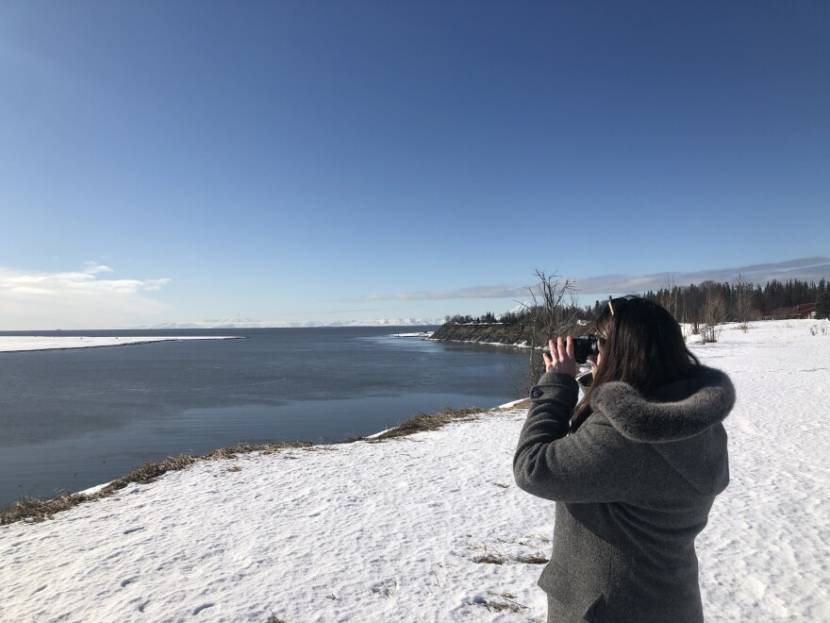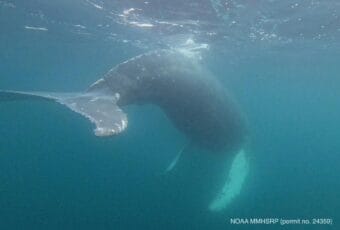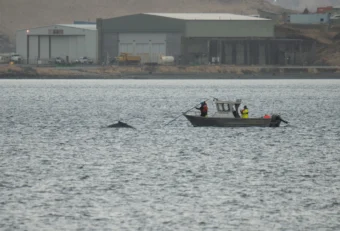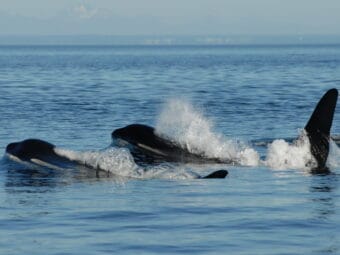
To the untrained eye, any flash of movement or ripple of water at the mouth of the Kenai River could be a beluga.
Not to Kelly Hild of Kasilof. She’s a trained beluga monitor, and she knows what to look for when she’s watching for belugas and reporting those sightings back to researchers.
“We do a lot of scanning,” she said, pointing toward the inlet. “From this spot you can see south. So if the whales were coming up from the south, you could see them there.”
Each spring, trained volunteers with the Alaska Beluga Monitoring Partnership perch on the Kenai and Kasilof bluffs and along Turnagain Arm. They’re trying to spot the critically endangered whales and record observations for researchers with NOAA Fisheries, so they can learn more about what the population is doing and why it isn’t rebounding.
Tuesday was the official first day of beluga monitoring on the Kenai. And Tuesday afternoon, visibility was great, minus a streak of sun glare on the river.
Hild, peering through a pair of binoculars, didn’t spot any belugas or seals from the park next to the Kenai Senior Center.
But she’s seen them many times before. This is her third season tracking belugas.
“It’s kind of addicting once you get out here and you start to kind of see the patterns and the times that they’re showing up,” Hild said. “And you think you have it, and I’m like, ‘OK, I know who’s gonna show up today.’ And then they trick you, and they don’t show up, or they show up and it’s a completely different group, or it’s half of the group. It’s very mysterious.”
Researchers know belugas are in the rivers in the spring and that they feed on fish there, including hooligan.
But beyond that, there’s a lot they don’t know about why the population goes upriver, says Deborah Boege-Tobin, a biology professor with Kenai Peninsula College who’s working on a beluga research project on the Kenai River.
“That’s part of the reason we’re monitoring,” Boege-Tobin said. “We think they’re going in the river to look for prey, but we don’t really know exactly.”
This year, volunteers are making observations even earlier than they usually do, said Teresa Becher, a coordinator for the Alaska Beluga Monitoring Partnership. Although the official start of the two-hour daily monitoring sessions was Tuesday, there have already been several sightings this month, including on a few occasions on the Kenai.
“The Kenai River broke up much earlier than it did last year than it did last year and the year before that,” Becher said. “And so the river is open now. The belugas have access and so they can come in and start looking to see what’s in the river, what’s coming down the river and what food is available right now.”
The first observation this year was March 10 — a mom and a calf on the river. Last year, the first sighting was March 25.
Becher tries to look for belugas most days on the Kenai River.
This week, she was traveling back into town just in time to start spring monitoring.
“I’m very very excited and assessing to see how they fared over the winter,” Becher said. “They’re a critically endangered group and so we want to make sure that they survived and that they thrive this season.”
The official observation season for Turnagain Arm starts a little later than the river season — April 1. Suzanne Steinert, who runs the nonprofit Beluga Whale Alliance, said that’s because the whales show up a bit earlier in the middle part of the inlet.
“So it’s not really known exactly why they hit that area first,” she said. “But in Turnagain Arm anyway, the hooligan run starts in April, and that’s when we really see them come into the upper inlet.”
But this year, monitors have already spotted whales on the arm, including an observation Saturday. On Tuesday, Steinert was heading out to the arm to take a look.
Hild, the beluga observer in Kenai, studied animal science in school. She finds watching the animals in their natural habitat fascinating.
And she’s hardly the only one. The Beluga Monitoring Partnership had nearly 30 volunteers last year, between March and May. While Hild was out on the Kenai bluff by herself on Tuesday, she’ll be joined later this week by other volunteers.
“Everybody comes from really cool backgrounds, and it’s not a group of people that I would’ve met any other way,” Hild said. “And it’s just kind of a little beluga family that comes together. And if you want to come out and volunteer, definitely reach out and meet us. The more eyes the better out here. It’s a really special experience that you cant really get anywhere else.”



